Frank Luke's SPAD XIII
In 1910, Armand Deperdussin founded the Societe Provisoire des Aeroplanes Deperdussin (SPAD). The company built racing airplanes designed by Deperdussin; a monoplane designed by Chief Designer Louis Bechereau in 1913 set a world air speed record of 125 m.p.h. that year. In August 1914, Deperdussin was arrested for embezzlement, but was released a month later without a final judgement (he was finally sentenced to five years in March 1917 but never served his sentence) due to the importance of his company and its products following the outbreak of the Great War. Louis Bleriot became President of the reformed company, now known as the Societe Anonyme pour l'Aviation et ses Derives which allowed them to keep the SPAD. Most importantly, Bechereau was retained as Chief Designer.
After designing the odd-looking SPAD A.2, a two-seater “fighter” in which the gunner sat in a “pulpit” immediately ahead of the propeller, Bechereau next designed the SPAD VII C.1, which utilized the 150 h.p. Hispano-Suiza V-8, armed with a single Vickers using the Constantinescu hydraulic gun synchronization system. Introduced to combat in August 1916 in limited numbers shortly after the appearance of the Albatros D.II, the SPAD VII would be an important part of the French and later Italian air forces for the rest of the war. At first, the airplane was faster than the Albatros, but not as maneuverable as its main opponent. With the later 180 h.p. Hispano, the SPAD became not only faster but more maneuverable.
In 1917, Bechereau designed the definitive SPAD XIII C.1, using the superb 220 h.p. Hispano-Suiza, which allowed an increase in armament to two Vickers machine guns. While the airplane did reach the front in limited numbers in the spring of 1917, difficulties in production, coupled with the necessity of a redesign of the upper wing, meant that it did not reach the front in appreciable numbers until late 1917 and did not fully replace the SPAD VII until the spring of 1918. It could not have arrived at a better time, as the last six months of the war saw more intense combat than the previous three and a half years. The SPAD XIII could fly and fight at altitudes approaching 20,000 feet, where air combat was now taking place, and could hold its own with the superb Fokker D.VII.
Every great French ace flew the SPAD XIII, which also began equipping squadrons of the U.S. Army Air Service in July 1918, where it saw outstanding service in the three months of fighting in which the American forces demonstrated they were the equals of their European allies and enemies. After the war, the SPAD XIII was used by air forces ranging from that of Czechoslovakia to Japan, and remained in first-line service with the U.S.A.S. until the early 1920s.
My Favorite Ace - Frank Luke:
I was somewhere in elementary school when I first read about Frank Luke, America's second highest-scoring ace of the Great War, in a book my father had bought as a boy: "Air Aces of the Great War." I immediately fell in love with the story of "The Balloon Buster." Indeed, what boy who had also been reading his father's collection of Zane Grey, who went religiously every Saturday afternoon to the old Park Theater on South Gaylord Street in Denver to see a western, would not immediately recognize and relate to Frank Luke?
Frank Luke is the living, breathing embodiment of that iconic figure of the American national myth: the lone gunslinger looked down upon by his social betters, who comes into town, allies with the local outcast, then cleans out the villains, making life safe for women and children and civilization, before disappearing into the sunset.
Luke was the only Medal of Honor Winner to accomplish that deed while AWOL; it is claimed that his C.O., Major Harold Hartney, said if Luke returned from his last mission, he would put him on charges for a general court-martial. This makes him even more mythic, representing the ideal of the man who goes his own way regardless, convinced he is right and that posterity will so declare him. Indeed, the only story about Frank Luke that is better than the myth is the true story.
Luke really was an Arizona cowboy. After graduating from high school in the then-frontier village of Phoenix, he began work as a cowboy and later a copper miner; his last job before the war was riding fence on a ranch outside Flagstaff. With his lack of formal education and lowly social background, it is amazing that he managed to qualify for the U.S. Army Air Service in 1917, but he did. He demonstrated and instinctual ability as a pilot, completing the normal 9-week flight training course in 7 weeks, having soloed after only 5 hours of dual instruction. Commissioned a 2d Lieutenant on January 23, 1918, he was in France that March. After further training at Issoudun, he was assigned to the 27th Aero Squadron in August, 1918.
To say that Luke did not fit in with a group of upper class and upper middle class college-educated young men who were primarily easterners is putting it mildly. Major Hartney quickly concluded that he was "the damnedest nuisance that ever stepped onto a flying field."
After several uneventful patrols, Luke took off solo on August 16, headed for a German airfield in search of combat, where he spotted six Albatros D.V fighters and dove on them, hitting tail-end Charlie. He came in for a second attack on his wounded enemy and shot the Albatros out of the sky, then entered a dogfight with the other five, then broke away from them and headed for the American lines. On the way, he was intercepted by four other German fighters, but gave them the slip and returned home. With no witnesses he couldn't claim the victory, and came in for ridicule from his squadron mates when he pressed the claim.
During his solo flights in the area, Luke had made friends among the pilots of SPA 3, "Les Cigognes." The only social class the French pilots recognized was that of the fraternity of fighting spirit, and they saw that in Luke. Whenever he couldn't stand the college boys back at the base, he went to visit the nearby Storks.
Out of his peers' ridicule came Luke's determination to take on a target no one could miss: the heavily defended observation balloons used to direct artillery along the front. Few pilots even tried to take out these dangerous targets, and only the Belgian ace Willy Coppens got more of them than Luke. Luke had befriended Joe Wehner, also an outcast because of German heritage at a time when anti-German feeling in America had been whipped so high by the government that my own grandfather's barn was burned down in April 1918 by his neighbors in San Luis, Colorado, for the crime of being named Weist, while my 5-year old father in Johnstown, Pennsylvania, had to change his dachshund's name from “Kaiser” to “Teddy” and keep the dog inside to save its life for the crime of being a “German dog.”
Luke began his battle against the balloons on September 12, 1918, when the American Army opened its St. Mihiel offensive. Joe Wehner flew top cover for him. On the first attack, Luke's guns jammed at the decisive moment. He climbed away, cleared the jam and dove back into the cauldron of fire. This time no one could say he made a false claim - the explosion of the balloon was seen across the front.
On his second attack two days later, Luke shot it out with the observer-gunner, Sgt. Munchoff of the 14th Balloon company, who only parachuted at the last moment. Asked by his squadron mates back at base why he hadn't shot the parachuting German, Luke replied, "Hell! The bastard was helpless!"
The next morning, both Luke and Wehner scored balloons and got home shot-up from fighting their way out of a formation of Fokkers. The evening of the following day they left separately, planning to rendezvous after another double score. Luke got his and shot down a defending Fokker for good measure. He saw another combat going on above, but had to break off and run in the face of superior numbers. When he returned to base, he discovered Wehner had not returned. Luke was inconsolable, and was sent off on leave in Paris. He returned early a week later.
On September 26, teamed with Lt. Ivar Roberts, Luke got into a dogfight with Fokkers before he could attack the target balloon. He got his opponent, but Roberts did not return. Luke went to stay with his French friends and returned September 29, claiming another balloon. Upon his return, he was grounded by Major Hartney for disobedience. Despite the order he took off again, determined to get the three balloons he had spotted.
Luke intended to attack from the west, out of the sunset. Over the ruined village of Murvaux, he was intercepted by ten Fokker D.VIIs. After a five minute dogfight, Luke broke away using the "falling leaf" maneuver to let them think they had gotten him. Just above the ground, he straightened out and flew on. Flying through a sky full of tracers, he burned the first two balloons nearly simultaneously, then turned for the third. At that moment, his SPAD was hit by a solid burst of fire that also hit him, and he faltered momentarily. He pulled out just before crashing and headed on, throwing hand grenades at the gunners on the ground to make them duck. As the last balloon burst into flame, he turned and dove on the German trenches, strafing them with the last of his ammunition.
Badly wounded, Luke force-landed in a field near the village. The smoke from his still-burning victims filled the evening air as he climbed out of the wrecked airplane and headed toward a small pool of water that may have been a stagnant shell hole. As German soldiers closed in to capture him, he pulled his .45 revolver and shot it out with them before falling, struck multiple times.
That night, American artillery swept the area. Thus, like Guynemer, no one knows where Luke is buried. The German officer who commanded the balloon company and would have been his captor ended his report of the incident with this statement: "He was a man of dazzling courage, one of the bravest we fought in the war."
Frank Luke's combat career had lasted 17 days (including his leave in Paris), during which time he destroyed 14 balloons and 4 aircraft. At the time of his death, he was the leading American ace. He was awarded the Medal of Honor for his final combat.
The Model:
The Hobbycraft kit came out around 1999. Modelers saw it as essentially accurate, though the decals were judged to be poor. Unfortunately, over the years, this is one of the few Hobbycraft kits that has not had the decals upgraded. Other than that, the kit is essentially accurate, with nicely-molded parts.
I decided I would do the kit out of the box, other than to replace the decals. There are detail inaccuracies that a dedicated modeler can correct without a lot of effort, but to me the discrepancies were not so obvious that I felt the need to do so.
All the parts fit well, and I only used cyanoacrylate glue to fill the centerline seam. I did use the Eduard 1/32 photoetch French WW1 seatbelts, and used instrument decals from the decal dungeon for the rest of the cockpit detail. As Bill mentions, Tom's Modelworks provides a very nice photoetch interior detail set for the kit, which I would recommend.
Luke's SPAD XIII was Bleriot-built. It's important to note that, because there is a difference in the camouflage pattern between those built by Bleriot and those built by Kellner. The Kellner pattern is the one most usually shown in SPAD profiles. Fortunately, the 1/48 PD Productions decal sheet includes three-view drawings of both patterns. This sheet also points out that the engine panels on either side of the nose on Luke's airplane were unpainted aluminum, an important detail since those panels were generally painted on most SPADs I also followed the PD call for the blue-white yin/yang markings on the wheel covers because they were colorful.
I used Gunze-Sanyo and Tamiya acrylics. The clear doped linen undersurfaces were done with Gunze "Sail Color," while the metal and wood surfaces - the gas tank, lower cowling and landing gear, were painted with a mixture of "Radome Color" and Tamiya “Desert Yellow.” On the upper surfaces, the light green was modern US "Light Green" (Gunze), with the dark green done with Gunze "RLM83 Dark Green." The brown was a mixture of "Cocoa Brown" and "Mahogany," (both Gunze), and the Khaki color was Tamiya "Buff." I used Tamiya “NATO Black” for the "charcoal" color. The blue nose and wheels were done with Tamiya “Blue.” I used dark brown “Wood Decal” on the prop.
Throughout, I airbrushed each color, then masked using thread along the edge of the mask to raise it and get rid of any ridges; most photos show this camouflage with a fairly hard edge, which is likely due to it being brushed.
The only decals I know of for Luke's airplane are those in 1/48 from Ministry of Small Aircraft Production and PD Productions. The MSAP decals are long out of production, and I am not sure of the current status of PD Productions. I used the MSAP decals for the national insignia, the squadron marking and the checkerboards, and the PD decals for the numbers. My friend John Lester kindly created 1/32 scale decals from these on his ALPS printer.
I attached the landing gear and the cabane and interplane struts, then attached the top wing. Rigging was done with .010 wire, painted gloss black so it can be seen more easily.
This is an excellent kit, that provides good value for the money and is largely undervalued by modelers. There is a good decal sheet from a company in Brazil that allows you to create Captain Eddie Rickenbacker's famous “#1.” I wish Hobbycraft would re-release this kit with good decals - I'd buy a few more of them.
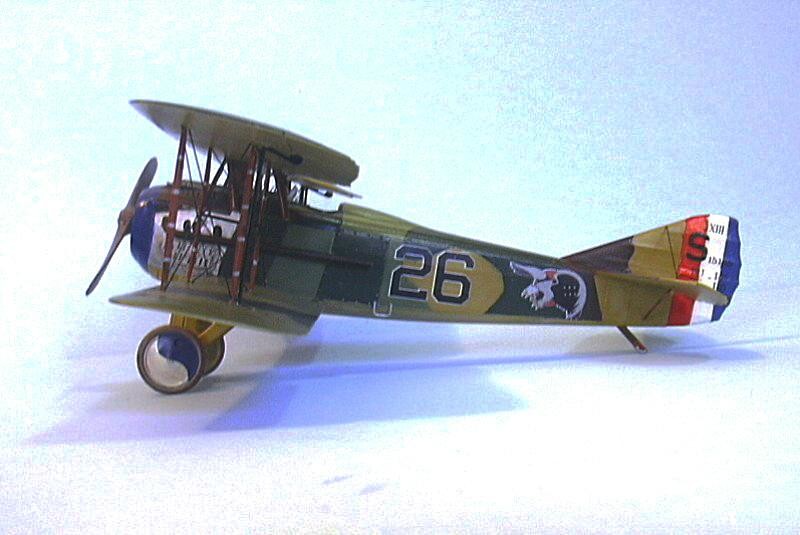
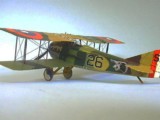
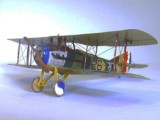
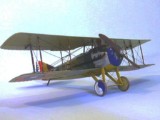
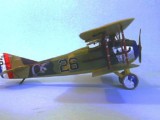
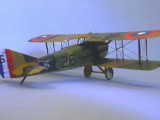
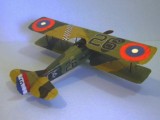
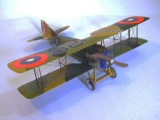
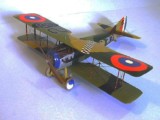
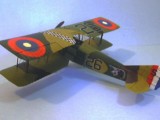
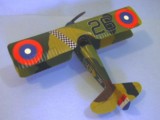
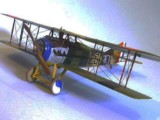
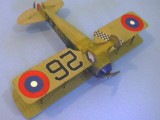
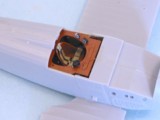
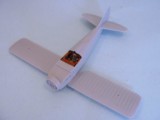
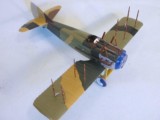
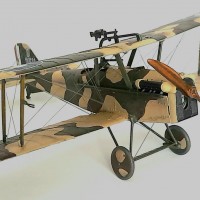
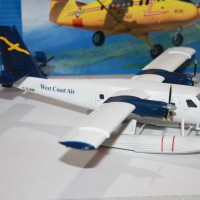
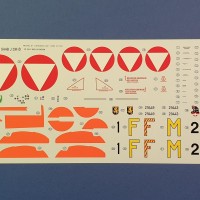
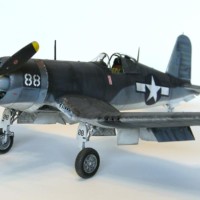
Nice story...nice pics...nice build...nice.
Another nice Spad!
Great work, Tom. I like your color choices.
Great SPAD!
Another great Spad and article...
Outstanding, Tom and the write-up, as always, is very well done. Like you, Luke was a boyhood hero of mine.
Mine, too. Being Irish, respect for authority sometimes isn't easy. Luke was an independent, coming from the last frontier (Arizona just became a state), and the latest in a series of solitary guys who went their own way. Folks like him are needed, but not easy to fit into the little boxes (or checkoff lists) beloved by management. Boone, Crockett, Travis, and their modern descendents.